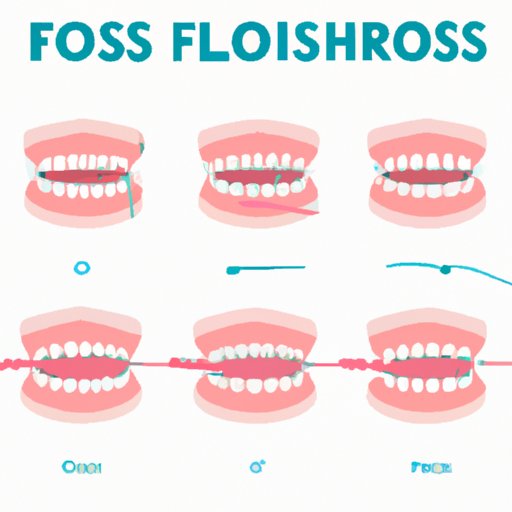
Introduction
If you have braces, you may find it challenging to keep your teeth clean and healthy. Flossing is an essential part of any oral hygiene routine, but how do you floss with braces? This article will guide you through the process, explaining the importance of flossing and providing tips on selecting the right tools.
Step-by-Step Guide
Flossing with braces may seem like a daunting task, but it is crucial to maintain optimal oral health. Follow these steps to floss your teeth with braces effectively.
Importance of Flossing with Braces
Flossing with braces is essential because braces can make it challenging to clean between your teeth, leading to food particles and plaque buildup, which can contribute to tooth decay, gum disease, and bad breath. Flossing helps to remove the food particles and plaque in these hard-to-reach areas.
Tips on Selecting the Right Floss
It is essential to choose the right floss when you have braces. Wax-coated floss, which glides easily between the teeth, is the best option. Avoid using regular floss, which can get stuck in your braces and cause damage.
Specific Instructions on How to Floss between Braces
Step 1: Take around 18-24 inches of floss and thread it under the wire below the bracket.
Step 2: Hold the floss tightly, with an inch of space between each hand, and slide it between the teeth. Gently move the floss up and down, curving it around the tooth to reach underneath and remove any debris.
Step 3: Remove the floss and thread under the wire and repeat the process on the next tooth.
Flossing Tools
If you find regular floss challenging to use, you can consider using floss threaders or orthodontic flossers.
Floss Threaders
A floss threader is a flexible plastic tool that helps thread dental floss between braces and teeth. Insert the floss through the threader and slide it under the wire. Use the floss as usual.
Orthodontic Flossers
Orthodontic flossers are like tiny brushes that have a thin tip that can fit between braces and teeth. They make it easier to reach the hard-to-reach areas between the braces.
Common Mistakes
Flossing with braces is not difficult, but it is easy to make mistakes. Here are some common mistakes and tips to avoid them.
Common Mistakes
– Not flossing at least once a day
– Not using the right tools or floss
– Being too aggressive and damaging the brackets or wires
Tips to Avoid Mistakes
– Floss at least once a day
– Use the right floss and flossing tools
– Be gentle when flossing
Benefits of Flossing
Flossing with braces has many benefits, such as preventing tooth decay, reducing the risk of gum disease, and preventing bad breath. Flossing also helps to keep your braces in good condition and avoid any damage to the brackets or wires.
The Importance of Regular Flossing
Flossing with braces can be time-consuming, but it is necessary to maintain optimal oral health. Regular flossing removes any food particles and plaque buildup, preventing tooth decay and gum disease, and keeping your smile healthy and bright.
Frequently Asked Questions
How often should I floss with braces?
You should floss at least once a day.
What floss should I use with braces?
Use wax-coated floss, which glides easily between your teeth and braces.
How do I floss around braces without pain or discomfort?
Be gentle when flossing and use floss threaders or orthodontic flossers to make flossing easier.
Tips for Sensitive Teeth
For people with sensitive teeth or gums, flossing with braces may be challenging. Here are some tips to make it easier.
– Use a softer, more flexible floss
– Use a flossing aid such as a water flosser or interdental brush
– Be gentle when flossing
Alternatives to Flossing
If flossing with braces is too challenging, there are alternatives, such as interdental brushes, mouthwash, and water flossers.
Interdental Brushes
Interdental brushes are small, cone-shaped brushes that can clean between the teeth and braces.
Mouthwash
Mouthwash can be used to clean hard-to-reach areas and kill bacteria in your mouth.
Water Flossers
Water flossers use a powerful jet of water to clean between your teeth and braces.
Comparison to Traditional Flossing
While these alternatives can be effective, traditional flossing remains the gold standard for removing food particles and plaque buildup.
Conclusion
Flossing with braces is essential to maintain optimal oral health. With the right tools, technique, and tips, flossing can be quick and easy. Remember to floss at least once a day, be gentle, and use the right tools. Your smile will thank you.




